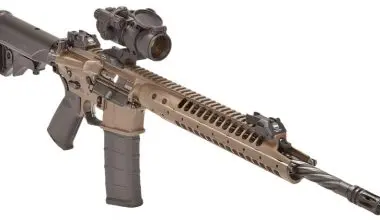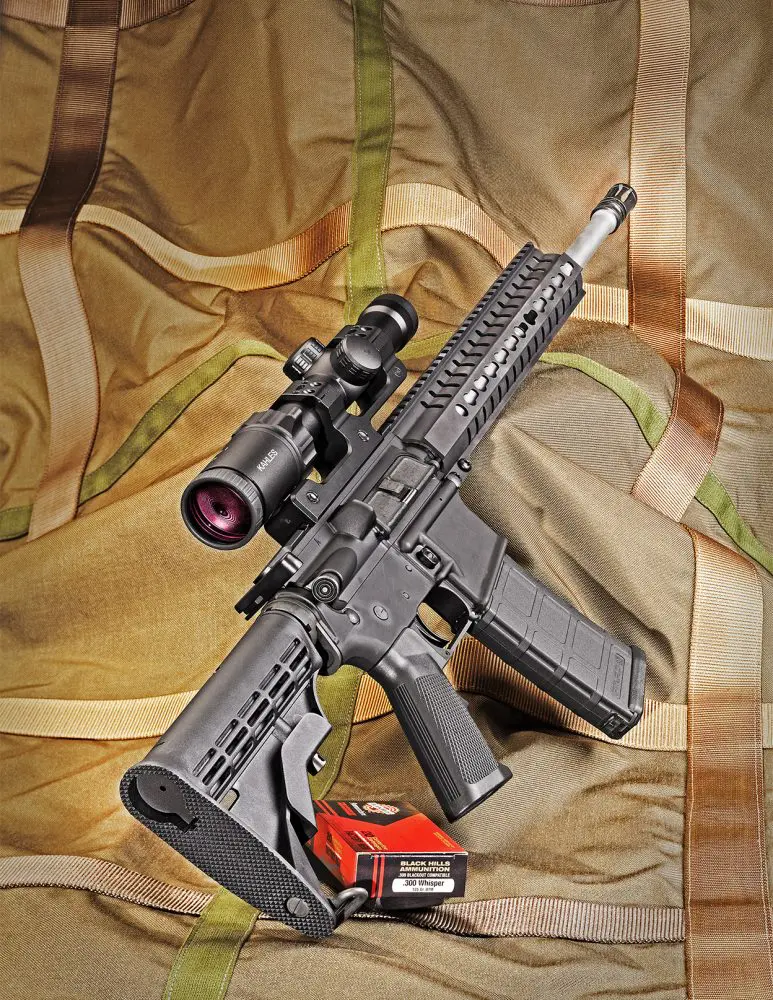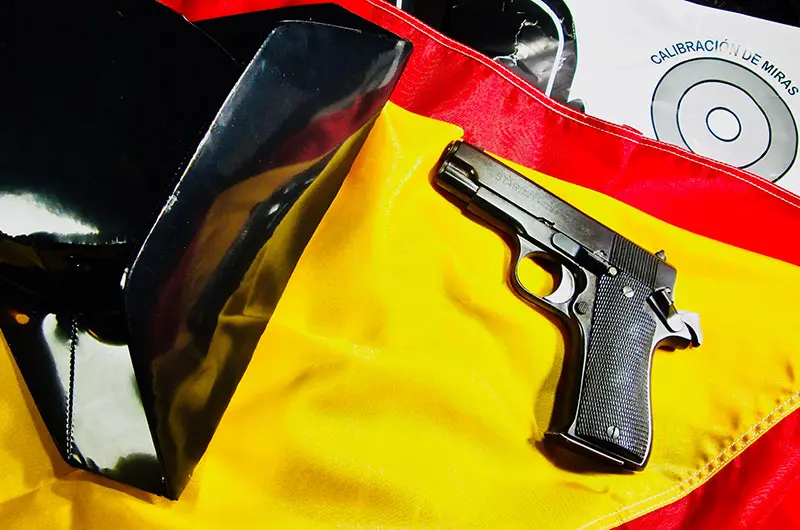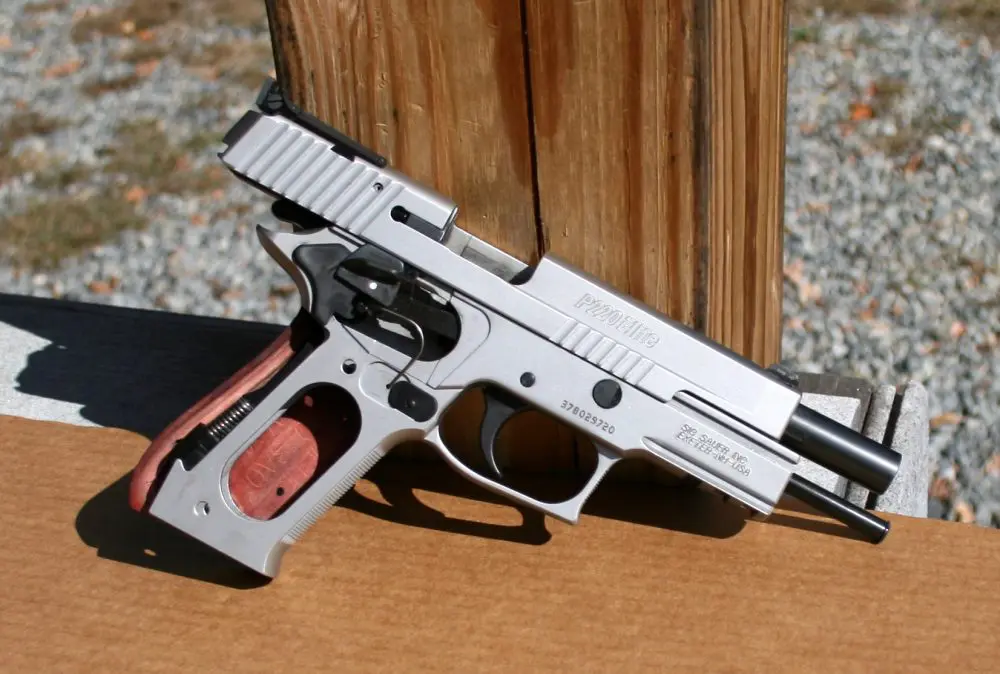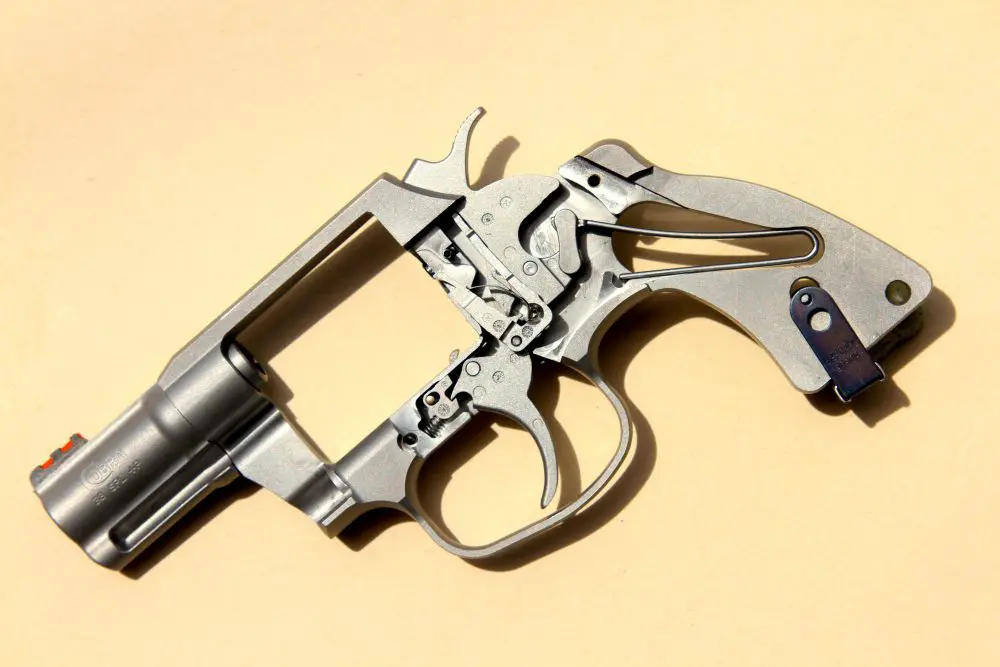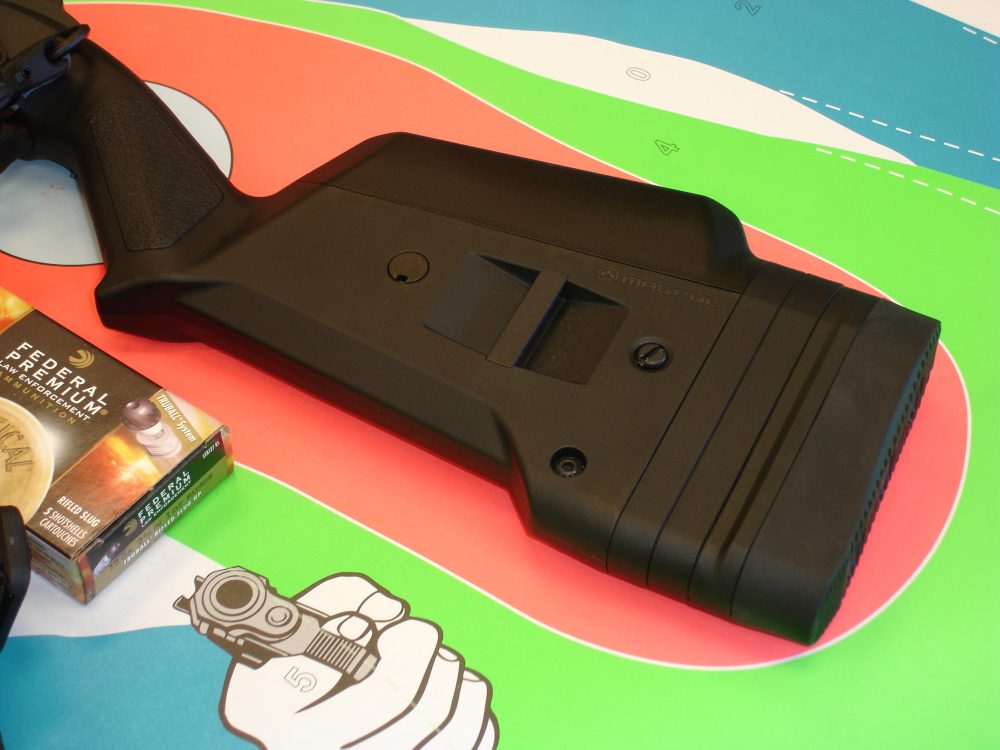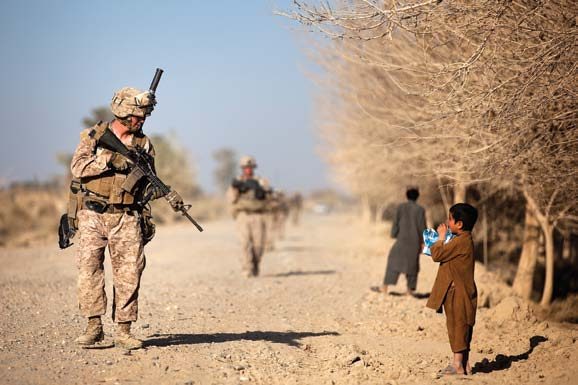
Table of Contents
Live From Afghanistan: Eyewitness Report
War is the ultimate proving ground
The last decade of conflict has seen trends wash over the battlefield, some sticking and others proving unworthy or simply bridging to better solutions.
Many of these trends come back home and move to the public safety and larger shooting sectors. I recently spent time in western Afghanistan and spotted a number of new or crystallizing trends.
PRIMARIES
There are several notable trends going on with the rifles in the Afghan fight. Despite differences in the primary weapon system among Army units, Marines, or even the Brit, Dane, and some Afghan forces, there are distinct trendlines. These trends are all making the rifleman increasingly capable in both day and night.
Sighting System
The first of these is the sighting system. Iron sights are almost non-existent except among U.S. reservists in support units and regular Afghan army soldiers with their M16A2s. The magnified optic is far and away prevalent, with most being fixed-power combat optics in the four-power range. The vast majority of these are Trijicon 4X32 ACOGs, with only the most minor of differences.
Whether the terrain is mountainous or desert, or shooting from one mud fortress rooftop to a partial target firing from a “murder hole” in another, the ability to bring the target in closer to see and verify the threat is enhanced.
Considering that a good many engagements take place toward the maximum range of the AK and RPG, this puts the optic-equipped fighter in a good position and allows the right guy to get shot. These optics are not without some drawbacks, good for an article itself, but have become the standard and are well used in the current fight.
Lights and Lasers
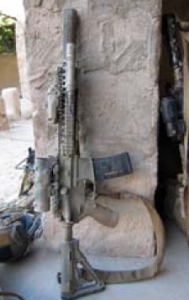
Lights and lasers have moved from specialty items into the mainstream. It is increasingly rare to see a primary of any ISAF (NATO) trooper or GI that doesn’t have at least one or the other mounted to a rail. Most of our frontline troops now have a white light and an IR laser and use both enough to appreciate them.
Transitioning from harsh sunlight into the dark interior rooms of a mudwalled living compound requires a good weaponlight to help bridge the eyes’ dark adaptation. There are a bewildering array of predominantly Sure- Fire products in active use for the white lights and at least half a dozen different lasers. Training on the devices does not seem to be as universal as the equipping, leaving room for even more capability as that gap narrows over time.
Magazines
Carbines are increasingly fed with Magpul polymer magazines, with the EMag standard issue for the Brits, and large numbers of American soldiers either being issued or personally buying PMAGs. Maglevel versions are the hot ticket with the boys, allowing a glance to verify the weapon’s ammo status. My experience indicates that the window might actually be more helpful to peers and leaders to ensure that the lackadaisical on the battlefield have actually gassed up their rifle … in a number of instances, I saw otherwise good men in sketchy places with the Maglevel clearly indicating they were eight to 10 rounds “light.”
My working theory is that coalition obsession with clearing barrels on Forward Operating Bases (FOBs) leads to a cycle of the primary magazine being depleted by one round with each return from the outside. The soldier removes and stows the magazine, cycles the round out of the chamber, probably pockets the single round and hops back in his armored vehicle to ride in to his unit area. Then the next trip out, the cycle repeats until someone else looks at the Maglevel window and points out the discrepancy. Probably not what Magpul intended, but useful nonetheless.
Grip Pod
All trends are not universally worthwhile nor applicable. A trend that is debatable in merit but nearly universal in practice is rifles with the Grip Pod vertical foregrip. Nearly every Brit and American long gun encountered was wearing one. The theory is that the grip deployed bipod, coupled with the aforementioned optic, turns every marginal shooter into a dinger and every shooter into a designated marksman (DM). There may be evidence to support that, but the piece of gear’s primary use seems to be to facilitate grounding the carbines neatly while in the chow hall.
I am not a fan of the grip pod, either as a vertical foregrip or a bipod, so I was surprised to find myself reluctantly admitting that on the Brit bullpup, the item seems to have real merit. The SA80/L85 makes it impractical to monopod off the magazine as can be done with the AR, while the recoil system rises but doesn’t return well to point of aim as an AR shooter is used to. The awkward butt-heavy balance of the L85 and limited space to stretch the support arm forward in prone made the grip pod pretty handy and helped the shooter to anchor the carbine down in multiple shots. In special units, grip pods are fairly scarce, though I did see one very talented and experienced shooter who had the grip pod on his M4.
Slings
Slings have moved through trends faster than women’s clothing in the last decade. In many circles, the evolution quickly moved from predominantly carry straps in 2001 to various adaptations of the three-point sling popularized on the MP5 by 2005, and then increasingly to single-point slings, and now the hands-down choice among experienced users overseas is the two-point sling—typified by the VTAC sling.
The two-point is so versatile that a wide variety of talented shooters in experienced units have settled definitively on it. Whether for its ability to help support some of the weapon’s weight on a long patrol, quickly transition to a lashed-down across-the-back carry, or facilitate transition to a secondary or hands-free without the catfish floppage that the single-point had, the two-point is in wide distribution.
An interesting variation on the singlepoint sling was also in limited usage,where the user would run a snap hook to center chest through tubular nylon, or a converted single-point that ran through the shoulder straps of the plate carrier and secured to the back of the vest.
With military distribution generally being unable to procure and supply at the same pace as battlefield trends, there are still a large number of three-point slings in service, but seeing them in use by young deployers next to an NCO who bought his own two-point quickly establishes the better product.
Personalization
Personalization is another growing trend. Increasingly there are aftermarket grips, stocks, rail covers, optics, and lights in use. This is largely positive, given a certain measure of quality. The unit “guru” effect is prevalent, with whoever the knowledgeable gun-guy is seeming to set the trend within a unit. This accounts for much of the variance seen, with certain units all sporting this or that item purchased with unit funds or as a group buy from individuals.
Painting of weapons is now much more common and less gasp-worthy than when it was restricted to snipers and SOF. The Afghan color palette tends to make black stick out prominently, so troops find a way to break up the big black stick, either through aftermarket furniture or with a can of Aervoe, Krylon or local paint.
7.62mm Semi-Auto Marksman’s Rifle
A sub-trend in primaries is the niche popularity of the 7.62mm semi-auto marksman’s rifle. It’s increasingly common to see any patrol that leaves with such a weapon, and the soldier carrying it is usually enthusiastic about it. Speaking with a wide variety of these guys, it was clear that they felt the platform allowed better hits and was more decisive when it connected with Talib meat.
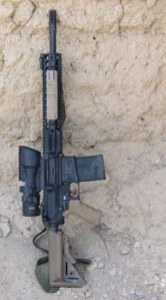
Interestingly, where the standard load-out for a rifleman varied by unit from 120 to 180 rounds, I never saw a 7.62mm equipped DM with more than 80 rounds, and many with only 50 to 60. As more and more units consider these weapons at home and abroad, I suspect there are several factors worth considering that play into their popularity.
Hit potential seems to be influenced by three things: support, sights and trigger. The weapons, whether Army or USMC M14 derivative EBR/EMRs, Brit LMTs, or U.S. M110 Semiutomatic Sniper Systems, are all heavy. This means the shooter usually forgoes snapshots and goes directly to a supported position on a rest or the bipod. Once there, the generally superior optic on the system allows him to clearly see his target and place the shot while cleanly pressing the better quality trigger. Better hits result.
Worth noting is that his mates usually provide the initial suppressive fire which allows the DM to do this, since his rifle is too heavy to use well from the shoulder.
SECONDARIES
Holsters
Holster trends have moved rapidly as well. A decade ago, the flap holster on a web belt was the norm. The beginning of the war saw the explosion of the drop leg or thigh holsters; the Blackhawk nylon and Safariland 6004 being the predominant choices.
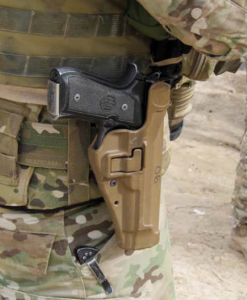
Right now the trend is quickly settling on the injection-molded, open-top modular-style hip holster. The Blackhawk SERPA was far and away the most visible and in wide use by both multiple U.S. branches and the Brits. As body armor has moved toward more minimalistic plate carriers and the troops operate more often from cramped armored vehicles, holsters have migrated off thighs and onto both gun and waistbelts.
Some more experienced hands still cling to the familiar thigh rigs, plus there are first timers who like the Han Solo swagger of some craptastic floppy nylon rigs, but they are dwindling in numbers. The SERPA’s mounting choices have allowed a significant number of those carrying pistols to mount them directly to the armor, usually around center chest. For those who truly need the capability to immediately transition to a secondary, the open-top retention holster mounted at hip or chest is fast and efficient; likewise for those working in cramped spaces where the pistol may be the primary weapon.
However, there are some concerns. The first is that the open top exposes the hammer to the rest of the user’s gear. I regularly saw both SIG P226s and M9s (carried off safe) whose hammers had been cocked in the holster by other gear or pouches grabbing the hammer spur and moving it as the warriors moved through operations. Likewise, 1911 ambi safeties are pretty easily swiped off.
This tendency heightens the second flea with the SERPA: the trigger finger releases the retention by pushing inward in the vicinity of the trigger guard. When the user is already under stress and awkwardly reaching around a variety of pouches to get to the holster, the unhappy stacking of factors can lead to some significant oopsies.
For most users, there may still be some merit in having a top loop cover the back of the pistol, both for additional protection from the elements as well as to allow the thumb to actuate a better placed release. However, the overall trend in holster design and placement represents real progress.
OTHER TRENDS
Knives I like big knives…
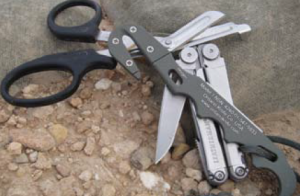
Combat is one of the few places where men can routinely carry big knives with a real sense of purpose in our modern society. Therefore it is with a degree of disappointment that I report the battlefield trend is decidedly away from blades. Whereas a short time ago it was routine to see Ka-Bars and a menagerie of custom or off-the-shelf Bowies, daggers, you name it, the modernization of conflict seems to have squeezed out the big blade.
It is much more common to see a seat-belt cutter, EMT shears and/or multi-tool on the belt or plate carrier than a fixed-blade knife. There were some unit exceptions, mostly in special operations units, but even then it was spotty.
Combat Casualty Care
Perhaps the most positive trend of all is the increased training and awareness of combat casualty care. Most of the fighting men have received pretty good training and are individually equipped to handle self and buddy aid to a degree never imagined before. This is fantastic and seems to be quickly spilling over into more mainstream emergency response and LE stateside.
Whereas pre 9-11 it was unusual, maybe even rare, to see soldiers with a ready tourniquet accessible on the outside of their load-bearing equipment, it is now rare to see a front-line troop who does not have at least one tourniquet prominently positioned and accessible to either hand. It is not unusual to see two, three or even four tourniquets on a man’s gear.
A decade ago, the mentality for individual first-aid kits was basically “break glass in case of emergency,” with few servicemen truly knowing the minimal contents or how to best use them. Today the trend is toward very effective individual first-aid kits, with many guys re-kitting extra pouches or fanny packs with extra tourneys and their preferred tape, bandages, gauze or hemostatic agents.
Will these trends endure and migrate into the norm? Maybe—in some cases, hopefully—although the collective experience that is pushing these may also indicate some additional refinements or equipment solutions to continue the cycle of innovation.
Onward and upward.
